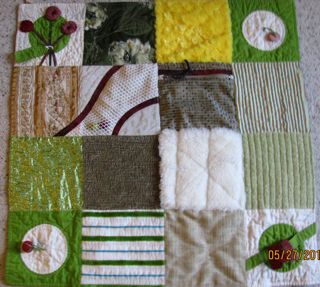
Quilts that dare to be known by touch alone: they must be seen with your fingers.
Touch quilts provide comfort, calming and stimulation for people with late-mid- to late-stage Alzheimer's disease and related dementias - people who constantly twist buttons and endlessly pick at 'lint'. They are also used with developmentally challenged people and autistic children. Larger versions are laid on the floor to tempt blind babies into crawling. And those of us with no particular diagnosis use them while reading or watching TV to keep our knees warm and our fingers amused. They are small, 30 to 36 inches square, with many textures and maybe some toys to intrigue the sense of touch.
I have become quite passionate about these quilts. Caregivers, whether in nursing homes or in the emergency, where I volunteer once a week, find the quilts lighten their workload and decrease patients' need for sedatives. The patients don’t say much, but they do cherish the quilts. The purpose of this website is to tell you about touch quilts: what they are, how to make them and give you some ideas for things, 'toys', to put on them.
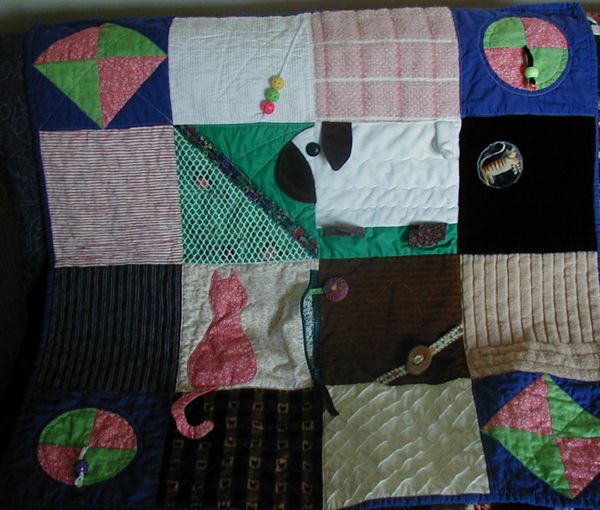
I started making them in 2006 after a workshop given by the Ottawa Valley Quilters’ Guild. Actually, I made my first quilt before the workshop, after figuring that the demo quilt was made of eight-inch squares and had dangles and other fun things on it. I got the idea of the sheep from a pillow bought at a craft shop in Ecum Secum, Nova Scotia. The cat with the pull-able tail was borrowed from a challenge quilt square. The slide was wood I picked up on the Chilkoot Trail. The stones under the net are real.
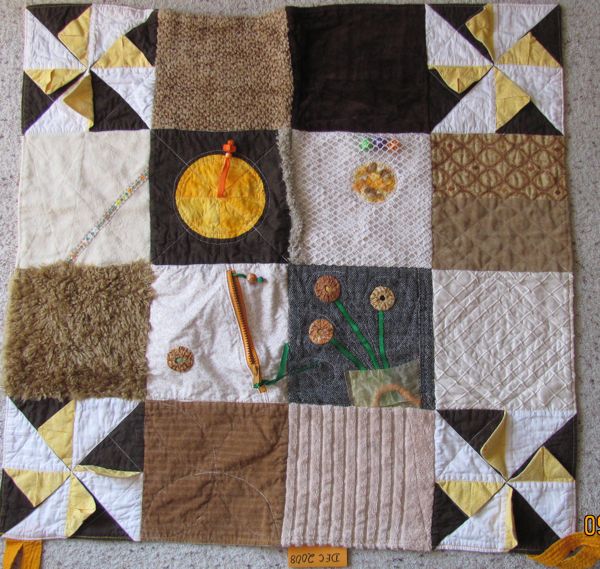
Of course, I learned a lot at the workshop, most obviously how important it is to attach attachments securely and how to do so, to bag my quilts instead of bind them, and not to use a heavy plastic d-ring. The other day I found a quilt I gave to the hospital right after the workshop -- still in use, although the stars on the flowerpot have washed off. This was the quilt that paid for the workshop. I never intended to do more.
However, volunteering in emergency, one cannot help but feel sorry for people who come in with dementia. It is not the dementia that brings them, but something else, a fall or heart condition, whatever. Yet they have no sense that they are in hospital, or even the idea that they need help. Several of the patients thought they had been kidnapped! The monitoring wires, they thought, kept them tied in the dungeon. One ninety-year-old woman needed to get “home to her children. I mustn't leave the babies so long.” She told me that her father would rescue her and I'd be sorry I confined her. Usually they just don’t know where they are and neither understand nor remember the care they are given. “I’ve been here three days and not a soul has spoken to me,” said one who had a nurse chatting with her five minutes before and had been there less than 15 hours. Poor lost souls!
And so I started making quilts. And asked other Guild members to do so. And finally started to give workshops. I learned more about touch quilts. I asked the caregivers what worked and what doesn’t. I tried new things. I developed methods for attaching dangles more securely: Alzheimer Patients may think beads are candy and try to eat them.
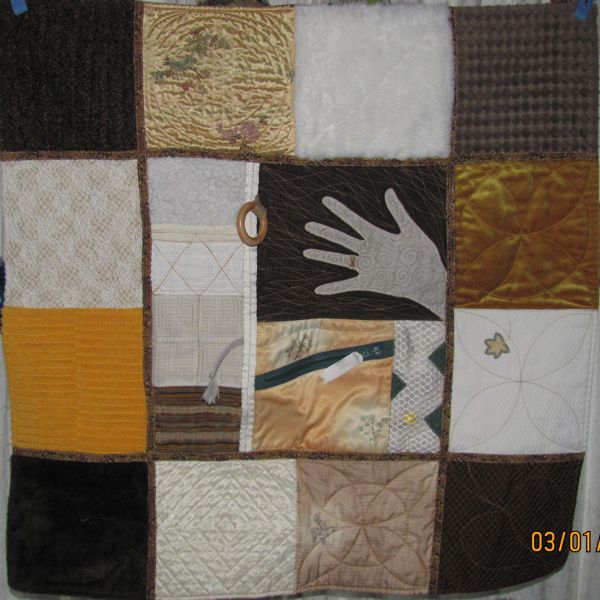
First I messed around with the four inside blocks, using up some small upholstery samples and other small scraps. I joined blocks with half-inch sashing. I made one with a 16” log cabin block in the middle.
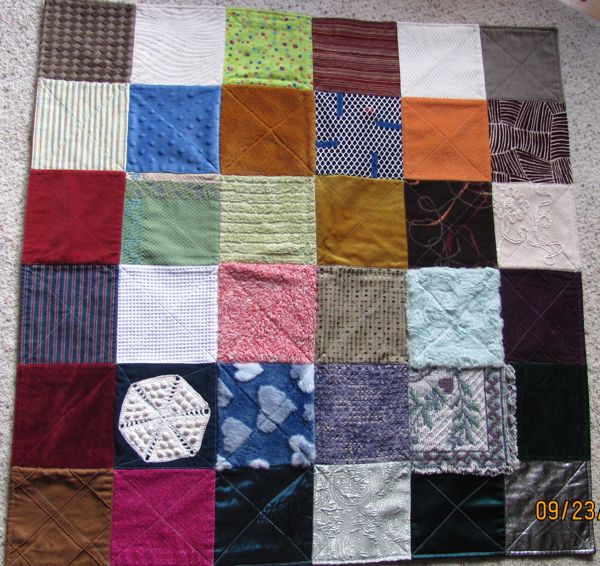
I learned that Kitchener-Waterloo and Manitoba Alzheimer Societies use six-inch-squares without toys to make a 36 square quilt and I tried that, too.
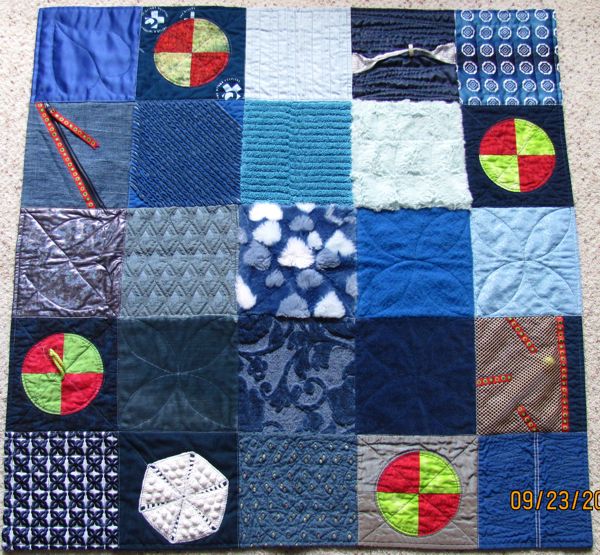
If 8” works and 6” works, why not 7” blocks? This one I call Twenty-Five Blues. The five by five block design has a single block in the centre with two rows of blocks around it giving interesting design possibilities. Here the thickest block is in the centre. The eight blocks around it are middling thick and the outside ring includes silks and cottons. The all-blue quilt was dedicated to a patient at one of the nursing homes OVQG donates to. I was there at Christmas time discussing with the program director the features -- good and not-so-good -- of a pile of quilts when I noticed a couple promenading around the foyer. They looked, I thought, like a honeymoon couple walking the decks of the Normandy in a 1930’s movie. They came in. The gentleman asked the director about the holiday program. His wife, with Alzheimer’s, eyed the quilts and reached to stroke a corner of intense blue peau de soie. “Ah, yes,” he said, “you do like blue, don’t you, dear. I bought her a necklace at the craft store.” She touched the blue beads at her throat and gave her husband a warm loving look that would have done justice to a necklace of sapphires from Tiffany’s. She smiled, touched a finger to her eye and uttered the only words I heard her say, “Blue. Blue.”
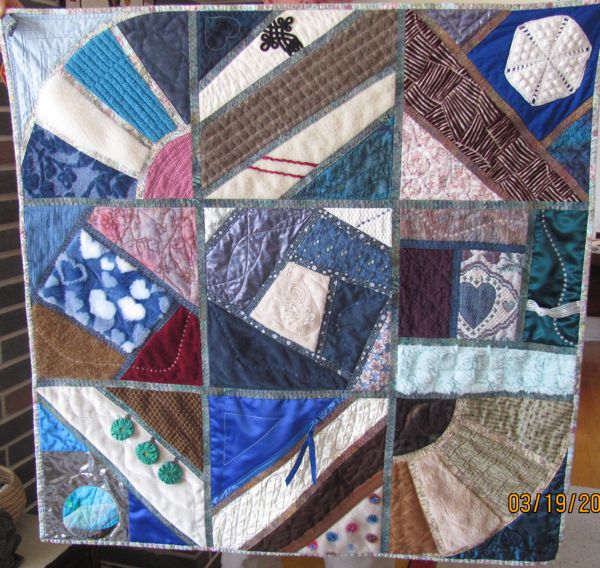
Finally, I had to try a crazy quilt. I thought it would be easy, but it is more easy to work yourself into a corner where nothing fits. This was my second or third attempt, made for a neighbour. I lay fabric on a 12.5" foundation square, which I later trim to about 11.5”. Then it is flip-and-sew and quilt-as-you-go.
My current project is to make and write directions for 35 toys and textures, in seven quilts. Three are done. Directions for making the blocks are found under "toys and textures".
I hope you have as much fun making these quilts as I do and as the recipients will have using them.
Copyright 2012 © Grace MacNab